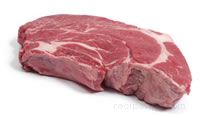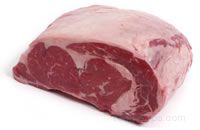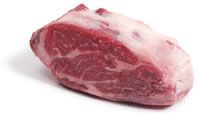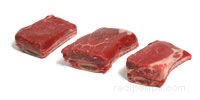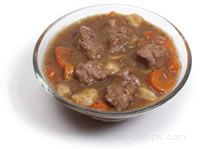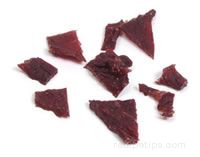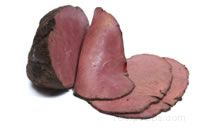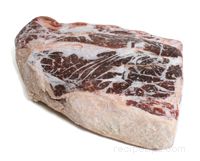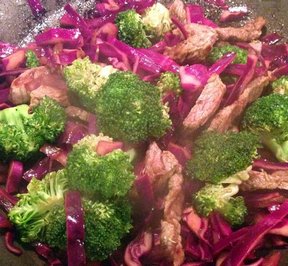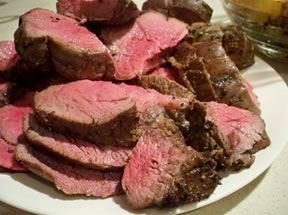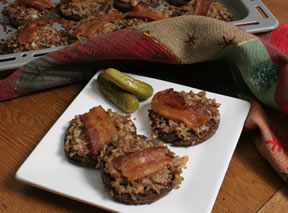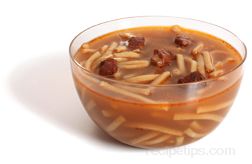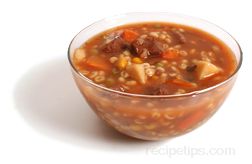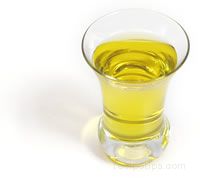Shopping Guide
Description of Cuts | Selecting Cuts | Inspection and Grading
Read the Label | Look and Feel | Quantity to Buy
Description of Cuts
Learning about various cuts can make shopping for beef a much easier experience. A general knowledge of beef cuts and how they are best used will help you select the proper cut for a particular recipe. Important points to learn are:
- The names of the primal cuts
- The names of the sub primal cuts
- The location on the carcass of the various cuts of beef
- The tenderness of the cut
- The leanness of the cut
- The most suitable cooking methods for each cut
The most tender cuts come from the loin and the rib. They should be cooked with high heat methods such as broiling, roasting, grilling, sautéing, and frying. Cuts from the round, chuck, brisket, plate, and flank are the least tender and are best suited for moist heat cooking methods such as braising/ pot-roasting, stewing, and steaming.
Various cuts of beef may differ in name between different countries and even in different regions of the same country, so it can be confusing. For example, in the United States, the rear section of the carcass is known as the round, but in Canada, the same section is called the hip. A more thorough description of beef cuts can be found in Cuts of Beef.
Selecting Cuts
Beef cuts should be selected according to the planned method of cooking. For example, if beef is to be cooked on a grill, a tougher cut from the round or plate should not be purchased, unless the intention is to tenderize the meat before cooking it. Even if the meat is tenderized, it will still not be as tender as a cut from the loin or rib, which do not require tenderizing. On the hand, there is no point in buying an expensive, tender cut, such as the tenderloin, if the recipe calls for the meat to be braised or stewed.
|
Oven Roasts
An oven roast is a cut of beef that is usually a minimum of 2 inches thick. The best roasts are obtained from the loin and rib primal cuts. They are very tender and they are expensive. The tenderloin, standing rib, and rib-eye are among the best oven roasts and benefit from the dry heat of roasting, but only if the meat is not overcooked. |
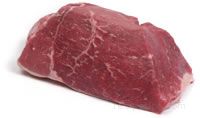 |
|
Cuts from the sirloin, such as the tri-tip or the top sirloin butt roast, are used more often than loin or rib cuts because they are less expensive. Some of the cuts from the round, such as the top round or eye round, are slightly tough and are better suited to braising than oven roasting. The bottom round (pictured) may be used as an oven roast if it is of the best quality and if it is roasted in a hot oven (450ºF). This will sear the exterior, which will seal in the juices, preventing the meat from becoming too tough.
A rib roast may be cut into two sections known as the first cut rib roast and the second cut rib roast. The first cut is also called a small end rib roast and includes ribs 9 through 12, which is nearer the loin primal. It is slightly more tender than the second cut, also known as the large end rib roast, which includes ribs 6 through 9 and is nearer the chuck cut. A rib roast may include the bones and is known as a standing rib roast or it may be boned, rolled, and tied and is known as a rolled rib roast.
The tenderloin is the most expensive cut of beef. Although the weight and length of the tenderloin may vary, the diameter of the trimmed tenderloin is always the same. A tenderloin that is not trimmed may weigh as much as 9 pounds. It may weigh as much as 5 pounds when it is trimmed. The trimmed tenderloin makes an excellent roast or it can be cut into smaller pieces and sold as filet steaks. |
|
Pot Roasts
A pot roast is basically a cut of beef that is cooked in liquid in a pot on top of the stove. Beef cuts from the chuck and round are most often used for pot roast. The chuck section has more fat than the round, which makes chuck roasts more flavorful than round roasts. Among the chuck cuts to look for when preparing pot roast are the 7-bone, boneless shoulder, arm, top blade (pictured), cross rib, and the boneless eye. |
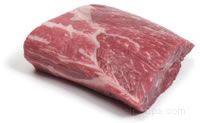 |
|
Most of the round cuts, which are often mistakenly purchased as oven roasts, are better suited to pot-roasting. Some of the best pot roasts from the round include the standing rump, the eye round, and the top round.
The brisket cut is also used for pot roast because it is very tough. The moist heat of braising helps to tenderize the meat. |
|
Steaks
Some of the most tender steaks are obtained from the loin and the rib sections of the beef carcass. They are also the most expensive. Among these are the filet mignon, T-bone, Porterhouse, rib-eye (pictured), and top loin strip, which are most often prepared with grilling or broiling. |
 |
|
Less expensive and a little less tender are the top boneless sirloin, tri-tip, and pin bone. They are also best when grilled or broiled, but they can become a bit tough if overcooked.
Steaks that are flavorful, but tough and require some tenderizing, especially if they are to be grilled or broiled, include the chuck top blade, chuck eye, chuck arm, top round, flank, skirt and hanger steak. |
|
Ribs
A short rib refers to a small piece that has been trimmed from the main portion of a rib when the rib cage is trimmed into smaller cuts. Short ribs are cut from the chuck and plate primals and back ribs are from the rib primal. Short ribs cut parallel to the bone are known as English style short ribs. They may include a bit of the bone or may be sold boneless. Short ribs that are cut across the rib bones are known as flanken. |
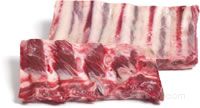 |
| Back ribs (pictured) are the portion remaining after a rib roast is boned. The full back ribs are long and do not have a lot of meat, but they are tender and tasty when grilled. |
|
Stir-Fry
When choosing beef for stir-frying, select cuts that are tender and benefit from the quick, high heat cooking process of stir-frying. The beef should be cut into small strips and should have very little fat. The strips will ensure that the meat will cook thoroughly, even when it is only cooked for a short time. |
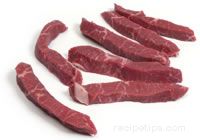 |
| The best beef cuts to use for stir-fry are various sirloin cuts or more expensive top loin and rib-eye. It is more practical to use tougher, less expensive cuts, such as chuck arm, bottom round, flank, or brisket, which can be marinated first to tenderize. Cutting the meat across the grain into small strips also makes a tougher cut seem a bit more tender. |
|
Stew Meat
Beef for stewing can be purchased already trimmed, cubed, and packaged in most food stores. It is often labeled "stew meat" without describing the cut from which the meat was obtained. Look for stew meat that has some marbling and connective tissue which will provide more flavor and help to keep the meat as tender as possible. |
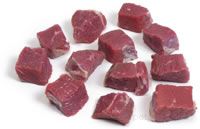 |
|
You can also purchase the beef cut of your choice and cut it into pieces at home. It may be less expensive to trim and cut the beef yourself and as a result, you will know exactly what you're getting.
Much of the beef used for stewing is obtained from the round cut, but almost any tough cut can be used because the stewing process helps to tenderize the meat. The best beef for stewing, in terms of tenderness and flavor, comes from the chuck. It has plenty of fat and connective tissue that melts during the stewing process, providing flavor and preventing the meat from becoming tough. |
|
Ground Beef
In order to be labeled ground beef, the product must be at least 70% lean. The package may say ground chuck, ground sirloin, or ground round based on the part of the animal from which the meat has been taken. It may just say ground beef, indicating that the meat may have been taken from several areas of the carcass. The leaner the ground beef, the higher the cost. |
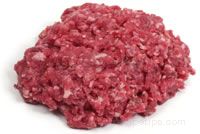 |
|
The fat content can of ground beef can be determined by the cut from which the ground beef has been obtained. A product labeled ground chuck will contain at least 20% fat. It may even contain more than 20% fat because it is legal for suppliers to add fat to the product as long as the fat content does not exceed 30%. A product labeled 70% lean ground chuck indicates that extra fat has been added and the product meets the minimum standards for ground beef. Ground sirloin usually contains about 15% fat and ground round contains about 11%.
Although some of the better ground beef may be labeled as ground round or ground sirloin, it may be difficult to know which cuts of beef have been used in a majority of the ground beef sold in food stores. In order to know exactly what you are getting, it may be beneficial to purchase the beef cut of your choice and then grind it at home, or you may have the butcher grind it for you. |
For more information on these and other products, see Beef Products.
| Note: When shopping for groceries, fresh beef (as well as other perishable products) should be selected last in order to reduce the length of time the meat is without refrigeration. If the meat is without refrigeration for more than an hour because of the travel time from the market, a cooler with ice should be used to transport the meat, and any other perishable food items, for the duration of the travel time. |
Inspection and Grading
USDA Mandatory Inspection
All beef sold in the United States must pass inspection by the Food Safety and Inspection Service (FSIS) of the United States Department of Agriculture (USDA). The mandatory inspection concentrates on the safety and wholesomeness of the meat and not necessarily the quality. Visual inspection for animal diseases is performed as well a number of scientific tests on a statistical sampling of beef. The tests are used to determine if any biological or chemical contamination is present in the meat. The primary concern is for the safety of the consumer.
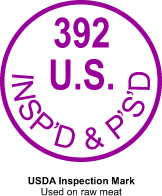
USDA Optional Grading
Unlike the mandatory inspection for safety, which is paid through government funding, beef grading is an option paid for by the processing companies that request the service. The processing companies use the grading information to determine how each beef carcass is best used. Beef is graded for quality and yield. The grade of the beef and the yield grade are stamped in several places on the carcass with an edible purple vegetable dye. Since grading is optional, not all beef sold in the United States is graded. Beef that has not been graded is known as "No Roll" because the rolling grading stamp is not applied to the exterior fat as is the case with graded beef.
|
Quality Grading |
| In terms of quality, the USDA grades meat according to the following: |
| Marbling |
Marbling refers to small pieces of fat within the meat. Marbling makes the meat more flavorful and tender, so an increase in the degree of marbling raises the level of quality, however, too much marbling or very thick pieces of marbling lowers the quality of the beef. |
| Age of Animal |
The best beef comes from animals that are 1½ to 2 years old. If the animal is older than 2½ years, the meat is tougher, but it is actually more flavorful. Moist heat cooking methods such as braising will help to tenderize older beef. |
| Miscellaneous Quality Factors |
Other factors that determine the quality of beef are color, texture, and firmness of the meat. |
The USDA uses 8 grading levels to represent the quality of beef.
The top 3 levels are Prime, Choice, and Select. |
 |
Prime
Prime is the top quality possible and represents only about 2% of the beef that is graded. It has the most marbling, which makes it the most flavorful and tender. Prime beef is usually only available to restaurants, but is occasionally found in some specialty meat markets.
The term "Prime Rib" is misleading as a description for a cut of beef because it may be mistakenly interpreted as meaning that the beef is graded "Prime". Prime Rib often refers to a rib roast and unless the meat is served in a better restaurant, the Prime Rib may actually be graded "Choice". |
 |
Choice
Choice beef is usually the highest grade found in food stores and represents about 45% of the graded beef available to the consumer. It has a fair amount of marbling and is juicy and tender (depending on the cut). |
 |
Select
Beef graded "Select" is the leanest of the top 3 grades and represents about 20% of the graded total. Because it is the leanest, the Select grade has less marbling than Prime or Choice. It is less tender and juicy than higher grades, but it is also less expensive. Beef graded "Select" is beneficial for people who are watching their fat intake and calories as well as their expenses. If all beef in the United States were graded, most of it would be graded "Select". |
| The other grades of beef as determined by the USDA are Standard, which is a notch below Select, followed by Commercial, Utility, Cutter, and Canner. Standard and Commercial grades are often sold in food stores as a store brand with no indication of the actual grade. Utility, Cutter, and Canner grades are never found in food stores, but are generally used for commercially canned meat products and sausages. |
| The grade of beef that is purchased not only makes a difference in the tenderness and overall quality of the meat, but also in the method that is selected for cooking. For example, a naturally lean cut such as a bottom round roast will have little difference in marbling between the Select grade and the Choice and Prime grades, but there may be just enough difference in a higher grade to allow the meat to be roasted (if it is not overcooked) rather than braised, which is the usual cooking method for most beef round cuts. |
|
Yield Grading |
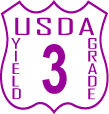 |
In addition to the quality grading, the USDA uses a yield scale to indicate the ratio of lean to fat within a beef carcass. Yield grade 1 is given to beef that provides the most meat and least amount of fat, while yield grade 5 indicates carcasses with the most fat. The yield grade is of particular importance to consumers interested in purchasing a whole or half beef carcass with the greatest percentage of usable meat. |
Religious Restrictions
In addition to the USDA mandatory inspection, some beef sold in the United States is butchered and processed under religious restrictions.
- Kosher: Kosher beef is processed using specific guidelines of Jewish law and with the supervision of special rabbis. Kosher meat refers to meat obtained from an animal which both chews its cud and has split hooves, such as a cow or sheep. The strict rules of slaughtering have necessitated the creation of regional centers where the slaughtering is performed. The meat is then shipped to local butchers.
Only the forequarters of a kosher animal are allowed for human consumption. For beef, this would include the area from the tenth rib forward. The hindquarters of the animal contain the sciatic nerve and fats that are forbidden to be eaten. A wide range of beef cuts, such as sirloin and Tbone steaks, are not available as kosher products. Many large food stores stock a range of pre-wrapped kosher meat and frozen meat products.
- Halal: Halal meat is processed by butchers who follow strict Islamic guidelines. Beef must be free of any other food components that are considered unclean and are prohibited for human consumption. Beef must be processed and prepared with equipment free from anything considered unclean. The meat must also remain free from contamination during the processing and preparation. A respectable authority must guarantee that the beef was processed and prepared according to the accepted guidelines in order for Muslim consumers to use the products.
Read the Label
The label on packaged beef provides a variety of information designed to make shopping as easy as possible. The label provides the following information depending on the type of beef product that is purchased:
|
Description of Beef Cut
The label on raw beef cuts contains the name of the primal cut the beef was taken from, the name of the retail or market ready cut, a short description (bone-in or boneless), the total weight, and cost per pound. If you are familiar with the different beef cuts, having the name of the cut on the label will help you determine if it is the proper leanness and/or tenderness for the type of recipe that you have planned. |
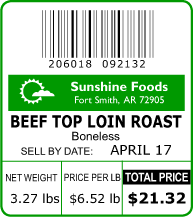 |
|
The name of the cut and whether it is bone-in or boneless will help you determine the quantity to buy according to the weight contained in the packages. A boneless cut will contain more servings than the bone-in cut, so it is important to take this into consideration when determining your needs. A bone-in cut may be lower in cost per pound, but when determining your best value, you should compare cost per serving. Another important point to consider is that the bone and fat help give beef great flavor and tenderness, so it may be worth paying a little extra per serving for the bone-in cut. To determine the cost per serving, use the following equation:
cost per pound / # of servings per pound = cost per serving |
|
Sell-By Date
Packaged fresh beef will have a "sell-by date" printed on the label, which represents the last day recommended for selling the product. Generally the store will pull any products left on the shelf the day of the "sell-by date". If the meat is properly refrigerated, it will remain fresh up to three days after the "sell-by date" but if it is not to be used within that time, it should be frozen. Some labels may have a "use-by date" rather than a "sell-by date", which indicates the meat should be cooked or frozen by that date. |
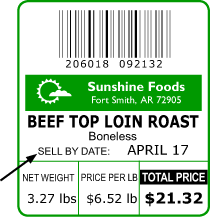 |
|
Fully Cooked / Ready-to-Eat / Heat and Eat
Some beef products are precooked, so the label will indicate that the product is "fully cooked" or "ready-to-eat". A product such as beef luncheon meat is ready-to-eat, but requires refrigeration and beef jerky is ready-to-eat, but it can be stored at room temperature. Other products, such as canned goods, are precooked, but taste much better if they are heated before they are consumed. These products are known as "heat and eat". |
|
|
Nutritional Labeling
All commercially prepared and packaged beef products are required to provide nutritional information on the label. Raw meat cuts in a food store or butcher shop are exempt from this requirement. The nutritional information shown on the label includes calories, fat and cholesterol content, protein, fiber, sugars, sodium, and various vitamins and minerals. |
|
|
Cooking Instructions
If a product is not fully cooked or ready-to-eat, the label may provide information for proper cooking. |
 |
|
Safe Handling Instructions
The label on raw beef or beef that is not fully cooked, will also contain food safety and handling instructions, which are required by the USDA. |
 |
Some packaged beef that is labeled "lean" may simply refer to the fact that the excess fat has been trimmed from the beef and may not indicate that the cut of beef is actually a lean cut. If you purchase cuts from the tenderloin or round, you can be sure that they are lean. The tenderloin will not only be lean, but it will be very tender and very expensive. Although round cuts are lean, they are not naturally tender, but they are much more affordable. Proper preparation and cooking helps to tenderize them.
Much of the beef intended for stewing is simply labeled "stew meat" without describing the cut from which the beef was obtained. In most cases, the meat is taken from tougher cuts such as the bottom round, brisket, or plate.
Look and Feel
|
When purchasing packaged fresh beef in a food store, the packages should be cold and the meat should be firm. The packaging should be in good condition with no tears or holes in the wrapping.
Beef that has begun to turn a gray color, has dried out edges, and does not smell fresh, should not be purchased. Fat on the edges of a beef cut should be a creamy white color (pictured right) and never yellow. |
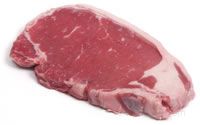 |
| Beef that has a slimy feel should be avoided. Excess liquid may indicate that the beef is old or has been stored at the incorrect temperature. It may also indicate that the meat has been previously frozen. Beef that has little excess liquid in the package is the best to purchase. |
| The best beef has a bright red color (pictured right). Packaged beef with a bluish-red color indicates that the beef has had a lack of exposure to oxygen due to the packaging. The beef will change to a brighter red once it is removed from the packaging and air has had a chance to circulate around it. Areas of darker red coloring are normal when oxidation occurs. Aged beef has a very dark surface. |
 |
| Marbling (pictured right), which refers to bits of fat that may be distributed throughout a cut of meat, is highly desirable in beef cuts. The small bits of fat tend to melt during cooking, which adds flavor to the beef and tenderizes it as it cooks. Cuts with the best marbling are usually rated "Prime" and are most often sold to restaurants and meat markets rather than to food stores. The marbling in prime cuts looks like fine strands that run throughout the meat. |
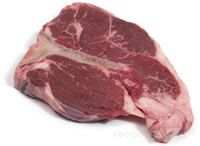 |
| Large quantities of very thick strands of marbling are found in lower grades of beef. Lean beef tends to be tougher after cooking because of the lack of marbling. The lean beef may be lower in fat and calories, but it lacks the tenderness and flavor of well marbled beef cuts. |
Quantity to Buy
The following are some points to consider when purchasing cuts of beef:
- Lean boneless cuts yield up to 4 servings per pound.
- Beef cuts with some bone yield up to 3 servings per pound.
- Bony cuts yield no more than 1½ servings per pound.
- One serving of a rib roast is equal to half a rib, so if you will be serving 8 people, a 4 rib roast should be purchased.
- 16 ounces (one pound) of ground beef produces about 4 cooked 3-ounce servings, which is the serving size recommended for a healthy diet.
- When planning a meal, it is always better to purchase too much beef than not enough. Always be prepared for people with larger appetites. If there are leftovers, cooked beef will keep in the refrigerator for several days or the unused portions may be frozen for long term storage.
| Type of Beef Cuts |
3 oz. Servings
Per lb. |
Type of Beef Cuts |
3 oz. Servings
Per lb. |
|
Steaks: |
|
Pot Roasts: |
|
| Tenderloin |
4.0 |
Chuck Arm (boneless) |
3.0 |
| Porterhouse |
2.5 |
Chuck Top Blade (boneless) |
3.0 |
| T-bone |
2.5 |
Cross Rib (bone-in) |
2.0 |
| Rib-eye |
3.0 |
Bottom Round |
3.0 |
| Rib |
2.5 |
Brisket |
4.0 |
| Top Loin Strip (boneless) |
4.0 |
Rump (bone-in) |
2.0 |
| Top Sirloin (boneless) |
4.0 |
Rump (boneless) |
3.0 |
| Chuck Top Blade |
3.0 |
|
|
| Top Round |
4.0 |
Ribs: |
|
| Flank |
4.0 |
Short Ribs (bone-in) |
1.5 |
| Skirt |
4.0 |
Short Ribs (boneless) |
2.5 |
| |
|
|
|
| Oven Roasts: |
|
Miscellaneous: |
|
| Tenderloin |
4.0 |
Stew Meat |
3.0 |
| Standing Rib |
2.5 |
Cross Cut Shanks |
2.0 |
| Rib-Eye |
3.0 |
Ground Beef |
4.0 |
| Tri-Tip |
4.0 |
Organ Meats |
4.0 |
| Note: You can save money by purchasing larger portions of beef and then dividing them into smaller cuts at home. Larger cuts of beef often cost less per pound because less preparation is required from the butcher. Make sure that you have a sharp knife and that any beef that will not be used is stored properly in the refrigerator or freezer. | |


























